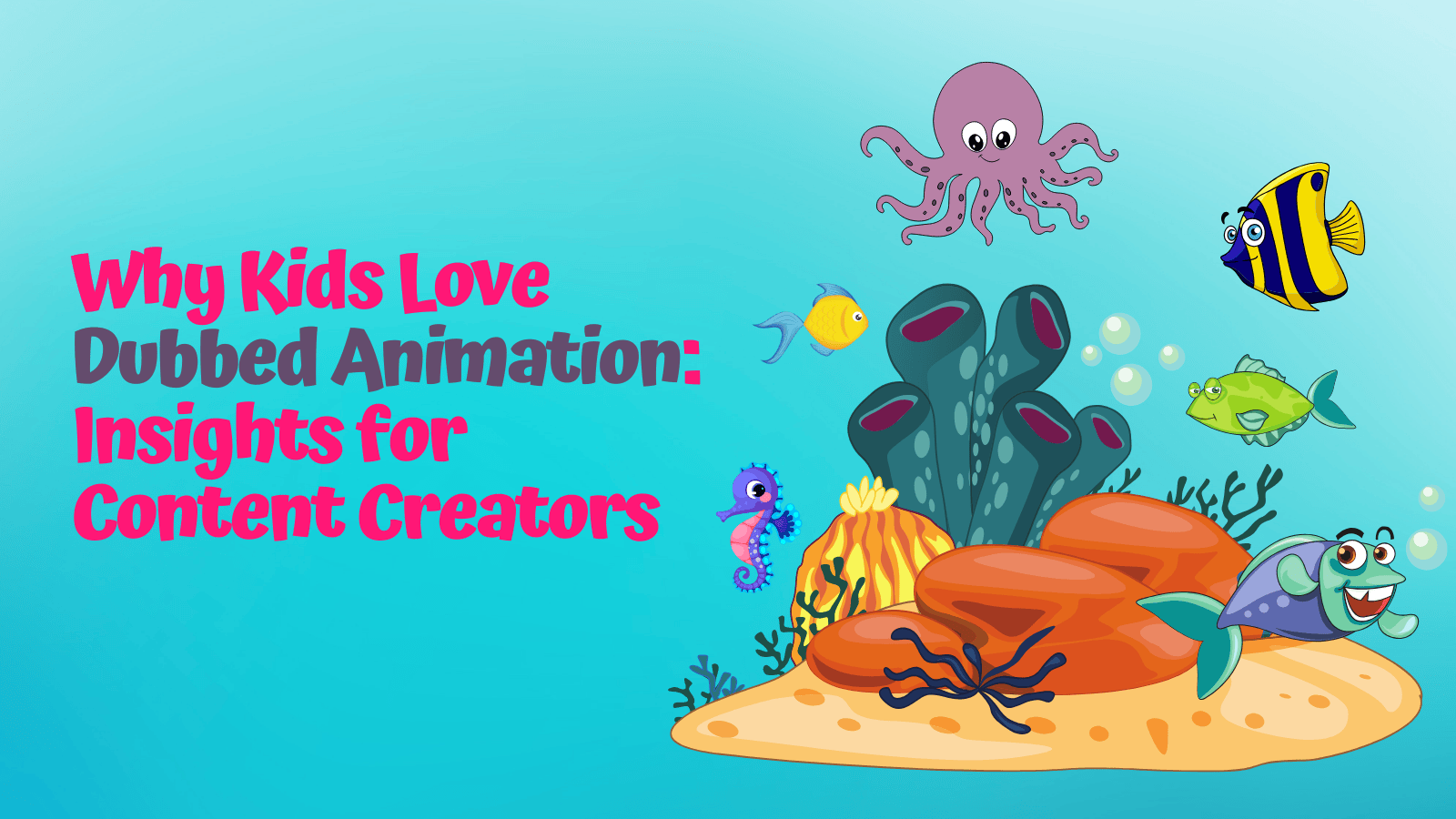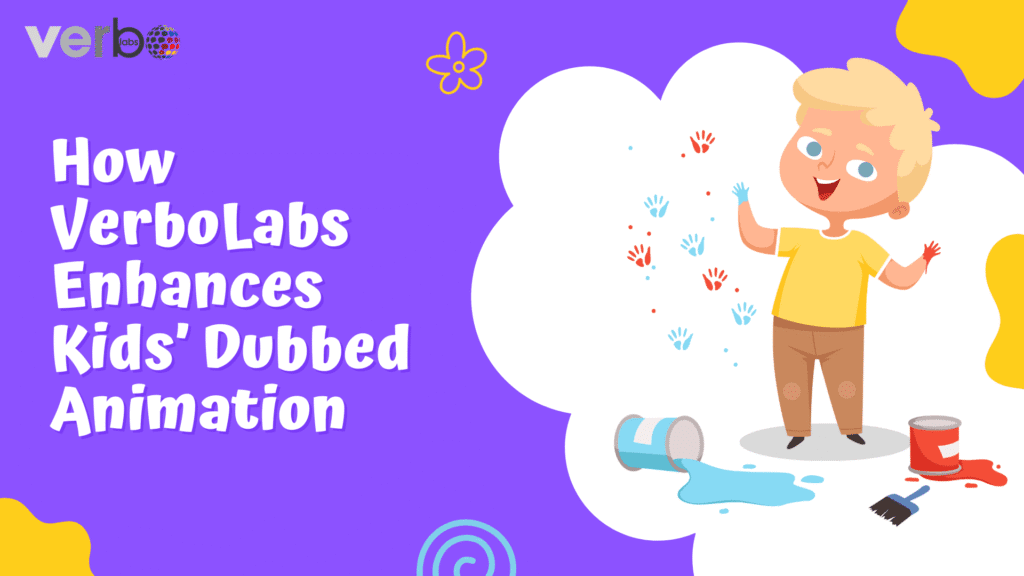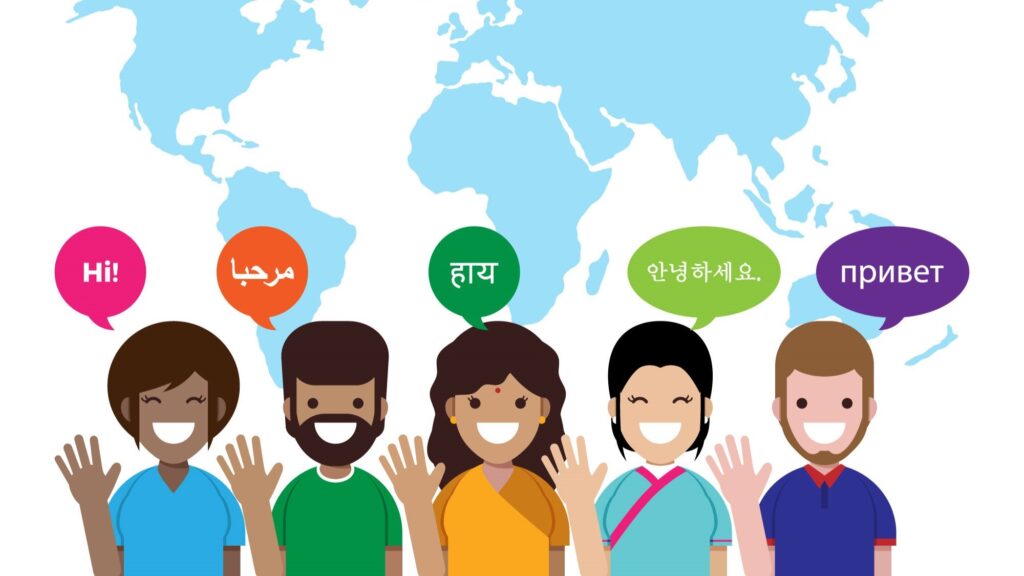
Dubbed animation for kids has become a significant phenomenon in the world of children’s entertainment. By translating content into different languages, dubbed animation makes it accessible to kids worldwide. This localization process is particularly vital for young audiences, who engage better with content in their native language. For content creators, understanding the importance of high-quality dubbing can enhance the reach and impact of their animated shows.
Why Kids Prefer Dubbed Animation
- Understanding & Emotional Connection
Children have an innate ability to connect emotionally with stories, characters, and dialogues when they are in a language they understand. Dubbed animations help kids grasp the plot and character motivations more effectively, leading to a deeper emotional connection and better understanding of the narrative.
- Cultural Relevance
Localization of animated content ensures that cultural references and nuances are adapted to the target audience. This process makes the characters and their adventures more relatable to kids, who see reflections of their own culture and everyday life in the animation.
- Engagement & Entertainment
Familiar voices and accents enhance the entertainment value of dubbed animations. Kids are more likely to immerse themselves in a show when the voices sound like those they hear in their daily lives. This familiarity helps maintain their attention and engagement throughout the episode.
The Role of Professional Dubbing in Kids’ Animation
- Improving Storytelling: High-quality voice-over can significantly enhance storytelling by bringing characters to life. Professional voice actors add depth and personality to animated characters, making them more believable and engaging for young audiences.
- Accurate Lip-Syncing and Expressive Voice Acting: Accurate lip-syncing ensures that the dialogue matches the characters’ lip movements, providing a seamless viewing experience. Expressive voice acting further enriches the animation, capturing the characters’ emotions and making the story more compelling.
- Machine-Generated vs. Human Voice Dubbing: While machine-generated dubbing has made strides in recent years, it still lacks the emotional nuance and expressiveness of human voice actors. Human dubbing offers a level of authenticity and emotional depth that is crucial for children’s animation.
Also read:
- The Evolution of Animation Dubbing: From Cartoons to Masterpieces
- What Is Animation Dubbing? A Complete Guide for Beginners
- What Is Animation? A Complete Guide to the Art Form
Key Elements of Effective Dubbing for Children’s Content
1. Choosing the Right Voices:
When it comes to dubbing animation for kids, selecting the right voice actors is paramount. Voices need to be carefully chosen to match the age, personality, and tone of the characters they portray. Child-friendly tones and expressions are essential because they ensure that the voices are engaging and relatable to young audiences. The right voice can bring a character to life, making it more appealing and memorable for kids.
2. Maintaining Original Emotions and Expressions
One of the most challenging aspects of children’s animation dubbing is preserving the emotional depth and expressions of the original dialogues. Effective dubbing ensures that the translated content retains the same emotional impact as the original, allowing kids to connect with the characters on a deeper level. This involves not only translating the words accurately but also ensuring that the tone, pitch, and pacing of the voice match the original performance.
3. Adapting Cultural References
Localization in animated content is not just about translating the language; it’s about adapting the content to make it culturally relevant and age-appropriate for the target audience. This adaptation helps kids understand and enjoy the animation without feeling alienated by unfamiliar references. For example, jokes, idioms, and cultural nuances need to be carefully adapted so that they resonate with the local audience.
Challenges in Dubbing Kids’ Animation
1. Maintaining Voice Consistency
Consistency in voice acting across episodes is crucial for character continuity. Kids form strong connections with the characters’ voices, and any changes in voice actors can disrupt the viewing experience and break the connection kids have with the characters. It is important to work with reliable voice actors who can commit to the entire series, ensuring that the characters’ voices remain consistent throughout.
2. Translating Humor and Wordplay
Translating humor and wordplay is often challenging in dubbing. Humor is deeply rooted in language and culture, and translating it without losing its essence requires creativity and skill. Effective dubbing involves finding equivalent jokes and playful language that resonate with the target audience while retaining the original charm. This may involve rewriting certain lines to make them funnier or more relatable to the local audience.
3. Keeping Young Audiences Engaged
Dynamic and lively voice acting is essential to keep young audiences engaged. Dubbing must capture the energy and excitement of the original content, making it enjoyable for kids to watch. Voice actors should use varying tones, pitches, and expressions to bring the characters to life and keep the audience entertained. Engaging voice acting helps maintain the kids’ interest and attention, making the viewing experience more enjoyable.
How VerboLabs Enhances Kids’ Dubbed Animation

- Expert Voice Artists: VerboLabs collaborates with expert voice artists who specialize in children’s content. These professionals understand the nuances of child-friendly dubbing and excel at bringing animated characters to life.
- High-Quality Dubbing and Localization Services: VerboLabs offers high-quality dubbing and localization services tailored to the needs of global content creators. Their attention to detail ensures that the dubbed content is culturally relevant and engaging for young audiences.
- Customized Solutions: VerboLabs provides customized dubbing solutions, helping content creators reach diverse audiences worldwide. Their expertise in multilingual voice-over ensures that animated shows are accessible and enjoyable for kids in different regions.
The Future of Dubbing in Kids’ Animation
1. AI vs. Human Dubbing
The debate between AI and human dubbing continues to evolve as technology advances. AI dubbing offers several advantages, such as speed, cost efficiency, and scalability. AI systems can generate multiple language versions of an animation in a fraction of the time it would take human voice actors, making it an attractive option for content creators looking to quickly expand their reach.
However, despite these benefits, human dubbing remains superior when it comes to delivering emotional depth and authenticity, which are crucial for children’s animation. Children form strong emotional connections with characters, and the nuances of human voice acting—such as intonation, timing, and expressiveness—are difficult for AI to replicate.
2. The Rise of Multilingual Streaming Platforms
With the growth of streaming platforms like Netflix, Disney+, and Amazon Prime, the demand for multilingual dubbed content is on the rise. These platforms cater to a global audience, and providing content in multiple languages is crucial for attracting and retaining subscribers. As a result, there is a growing need for dubbing services for animation to ensure that kids’ shows are accessible and enjoyable for viewers worldwide.
This trend is reshaping the content creation landscape, encouraging more creators to invest in high-quality dubbing. Multilingual streaming platforms are also driving innovation in dubbing technologies and practices, as they seek to offer the best possible viewing experience for their diverse audiences.
3. Shaping Content Creation
The increasing demand for dubbed animation is driving innovation in content creation. Producers and studios are recognizing the importance of quality dubbing in making their shows appealing to a global audience. This shift is leading to greater collaboration with professional dubbing studios and voice actors who specialize in children’s content.
As the industry evolves, content creators are exploring new ways to enhance the dubbing process. This includes using advanced technology to improve lip-syncing accuracy, experimenting with different voice styles to match characters more closely, and incorporating cultural nuances to make the content more relatable to local audiences. By investing in high-quality dubbing, producers are ensuring that their shows stand out in a competitive market, making dubbed content a staple in children’s entertainment.
Conclusion
Dubbed animation is more than just a translation; it’s a gateway to a world of entertainment for kids. High-quality dubbing enhances their viewing experience by making content accessible, relatable, and engaging. Content creators should prioritize high-quality dubbing to reach and resonate with young audiences worldwide. Partnering with VerboLabs for expert animation dubbing services can ensure that your content stands out and captivates children globally.

Bring your stories to life—partner with VerboLabs for expert dubbing and make your kids’ content engaging worldwide.
FAQs
Kids prefer dubbed cartoons because they can understand and enjoy the content without the distraction of reading subtitles. Dubbed animation allows them to immerse fully in the story and characters.
Dubbing improves understanding by presenting the story and dialogues in the child’s native language. This linguistic familiarity helps kids grasp the plot, emotions, and cultural references more effectively.
Key factors include choosing the right voices, maintaining emotional depth, accurately lip-syncing, and adapting cultural references. These elements ensure that the dubbed content is engaging and relatable for young audiences.
While AI dubbing offers efficiency, it often lacks the emotional nuance and expressiveness of human voice actors. For children’s cartoons, human dubbing remains the preferred choice for delivering authentic and engaging performances.
Content creators can ensure high-quality dubbing by collaborating with experienced dubbing studios like VerboLabs. Investing in professional voice actors and localization experts will result in engaging and culturally relevant dubbed content.



